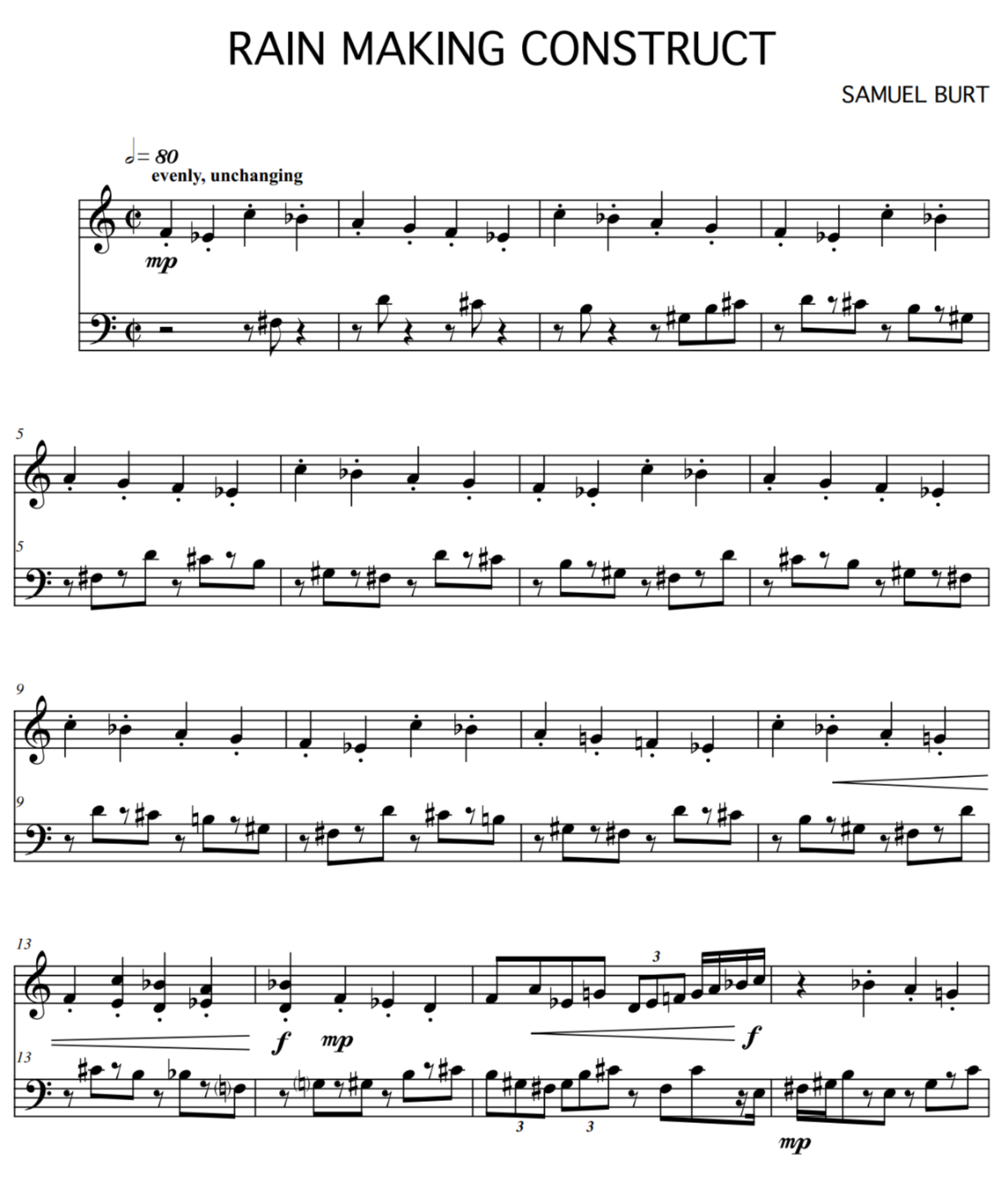Work samples
-
WymanParkDell ExcerptExcerpt from a performance of Burt's composition Wyman Park Dell. Led by Patrick McMinn on solo trumpet. Other performers were Rose Burt, soprano saxophone; Samuel Burt, clarinet; Patrick Crossland, trombone; Emily Joseph, trombone; Jessica Keyes, soprano saxophone; Liz Prince, tuba; and Adam Schuman, trumpet.
-
Burt-HumbabasTrod.mp3Humbaba's Trod is a work composed of daxophone recordings. The daxophone is a bowed wood instrument which is symbolic in relation to Humbaba. Humbaba guarded the cedar forest where the gods lived until Gilgamesh came and fought Humbaba and then cut the trees down to build the gate of a city. The daxophone provides a wide range of sounds (both in pitch and color). It was perfect for generating a rain forest type of environment where each "creature" inhabits a particular range. This work was performed first at Goucher College during the computer music concert.
-
Fable's KissComposition, Performance, and Animation by Samuel Burt. Composed for Mind on Fire's pandemic-inspired Facebook Stream. Fable's Kiss combines composition techniques originating from central Africa with clarinet extended technique.
-
Fountain ResonancesA piece combining the best extended techniques with beautiful layers of shimmering string textures. Composed to be maximally challenging yet easy to assemble. This is an excerpt of the ending of Fountain Resonances. Performed here by C.R. Kasprzyk and string players from the Peabody Conservatory.
About Samuel
Baltimore City

Samuel Burt is a composer in Baltimore, Maryland. His compositions have been performed across the U.S. As an improviser, he has performed for audiences in Atlanta, Baltimore, Chicago, New York, Pittsburgh, and other U.S. cities and has made numerous appearances in the international High Zero Festival. As a board member of the High Zero Foundation since 2005, he has helped curate the High Zero Festival, Red Room series, and Worlds in Collusion.
Inspired by John Cage, Burt pursues… more
Inspired by John Cage, Burt pursues… more
Jump to a project:
Extravagant Toys
Before formal study of electronic music in college, grade-school Samuel Burt used an Atari computer to sequence music for his stop motion videos. With the isolation of the pandemic, Burt once again turned to solo composition work with electronics. Extravagant Toys showcases a small selection of Burt's efforts on modern Eurorack synthesizers. To see the unfiltered, raw, almost daily work check out his Instagram account at daxophonesam.
-
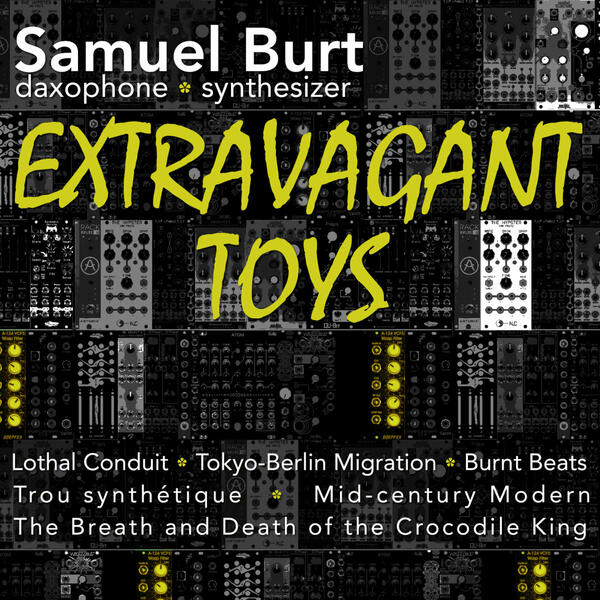 extravagant.jpgThe album cover for Extravagant Toys available on Bandcamp.
extravagant.jpgThe album cover for Extravagant Toys available on Bandcamp. -
Mid-Century ModernCreated with a physical-modelling synthesizer and a live granulator, Burt composed this music that is reminiscent of the orchestral works of Darmstadt composers in the 1950s and 1960s. Complex timbres can be carefully built out of the infinite sounds available on a synthesizer.
-
Tokyo-BerlinThis is a composition featuring Eurorack synthesizer and daxophone played by Samuel Burt. The disparate sounds dance around each other with similar shapes and colors. Live granulation extends the acoustic daxophone sound into new warped electronic spaces.
Wyman Park Dell
A performance for socially distanced ensemble and audience.
Composed for trumpeter Patrick McMinn and an ensemble of any assortment of instrumentalists, Wyman Park Dell was first performed September 13th, 2020 in Baltimore's Wyman Park Dell. The video depicts the second performance which occured on Stoney Run Trail in Baltimore, October 24th, 2020. This piece was optimized for outdoor performance, with a virtuosic trumpet part and parts for the ensemble that required no rehearsal. The ensemble blends with the natural environment, with uncoordinated rhythmic structures that mimic groups of insects, frogs, and birds.
Composed for trumpeter Patrick McMinn and an ensemble of any assortment of instrumentalists, Wyman Park Dell was first performed September 13th, 2020 in Baltimore's Wyman Park Dell. The video depicts the second performance which occured on Stoney Run Trail in Baltimore, October 24th, 2020. This piece was optimized for outdoor performance, with a virtuosic trumpet part and parts for the ensemble that required no rehearsal. The ensemble blends with the natural environment, with uncoordinated rhythmic structures that mimic groups of insects, frogs, and birds.
-
WymanParkDell ExcerptExcerpt from a performance of Burt's composition Wyman Park Dell. Led by Patrick McMinn on solo trumpet. Other performers were Rose Burt, soprano saxophone; Samuel Burt, clarinet; Patrick Crossland, trombone; Emily Joseph, trombone; Jessica Keyes, soprano saxophone; Liz Prince, tuba; and Adam Schuman, trumpet.
-
wpd_page.PNGA page from Wyman Park Dell. The score was written to provide a liberal amount of freedom to the solo performer. Burt wrote parts for the ensemble aiming for complexity through simplicity, allowing performers of all skill levels to contribute with minimal preparation. The score is modular, scaling up to accommodate any number and type of instruments.
Daxophone Construction and the Daxophone Choir
The daxophone, pictured, has unlimited potential for making new (singing, grunting, hooting, drumming, scatching) noises. It's played by clamping a piece of thin wood, bowing it, and placing another heavy piece of wood on it to change the vibrating length. Each carefully chosen and shaped pieces of wood are called tongues. They are both a sonic and visual art. Each is unique in wood grain, shape, and sound.
Samuel Burt built his first daxophone in 2011 consulting with the inventor Hans Reichel. He held a daxophone workshop at the Red Room in 2019 with aims to form a daxophone choir, playing compositions by living composers and arrangements of older music.
Burt plays daxophone in the band Coy Fish led by Sarah Hughes. They released a self-titled album. They opened for the Library of Congress's "Summer Movies on the Lawn" screening of the Wizard of Oz. Maria Shesiuk and Burt collaborated as Lightning Golem to produce an album of daxophone and synthesizer music called Cryptid Research. Burt engineered a recording of a session in Athens, Georgia, of himself on daxophone, Jeff Crouch on trumpet, and Killick Hinds on fretted Walrus guitar. He released it as Sneaky E.
Burt composed music for two daxophonists and percussion, performing it with Eric Franklin and Shelly Purdy at Artscape 2018. The work, entitled Renku No. 1, is built around a form of Japanese poetry where individuals add stanzas to a poem.
He's built 20 daxophones. Considering a daxophone for yourself? http://samuelburt.com/daxophones/
Samuel Burt built his first daxophone in 2011 consulting with the inventor Hans Reichel. He held a daxophone workshop at the Red Room in 2019 with aims to form a daxophone choir, playing compositions by living composers and arrangements of older music.
Burt plays daxophone in the band Coy Fish led by Sarah Hughes. They released a self-titled album. They opened for the Library of Congress's "Summer Movies on the Lawn" screening of the Wizard of Oz. Maria Shesiuk and Burt collaborated as Lightning Golem to produce an album of daxophone and synthesizer music called Cryptid Research. Burt engineered a recording of a session in Athens, Georgia, of himself on daxophone, Jeff Crouch on trumpet, and Killick Hinds on fretted Walrus guitar. He released it as Sneaky E.
Burt composed music for two daxophonists and percussion, performing it with Eric Franklin and Shelly Purdy at Artscape 2018. The work, entitled Renku No. 1, is built around a form of Japanese poetry where individuals add stanzas to a poem.
He's built 20 daxophones. Considering a daxophone for yourself? http://samuelburt.com/daxophones/
-
 daxophone_display.jpgDisplay of daxophone tongues (foreground), daxes (left), daxulele (right), desk mounted daxophone with kalimba tongue (center), and tripod daxophone (center, rear). The tongues are the interchangeable part of the daxophone that provide different sounds and pitch ranges. A dax changes the vibrating length of the tongue to change the pitch. Each body amplifies the vibration of a clamped tongue.
daxophone_display.jpgDisplay of daxophone tongues (foreground), daxes (left), daxulele (right), desk mounted daxophone with kalimba tongue (center), and tripod daxophone (center, rear). The tongues are the interchangeable part of the daxophone that provide different sounds and pitch ranges. A dax changes the vibrating length of the tongue to change the pitch. Each body amplifies the vibration of a clamped tongue. -
Parasympathetic_Activation.mp3A track from Cryptid Research, a collaborative electronic music recording project with Maria Shesiuk involving synthesizers and daxophones. This track features the daxophone through a talk box, doubling-down on the "mouthiness" of its sound.
-
Enunciator_Excerpt.mp3A recording produced from playing the daxophone through custom built software, written by Burt in Pure Data, designed to add consonant resonances to individual sound events.
-
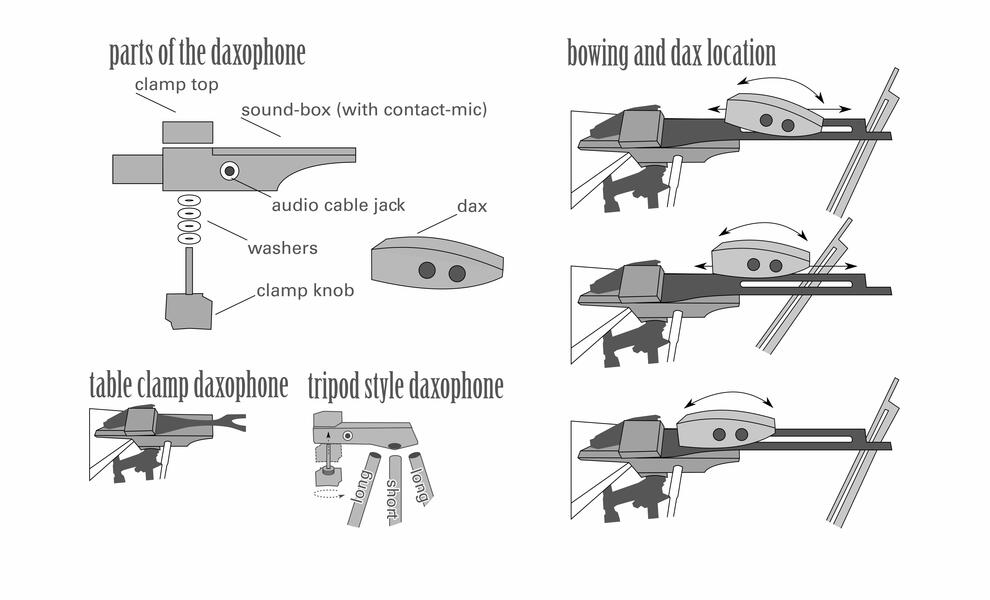 daxophone_assembly.jpgDiagrams of daxophone assembly and performance technique.
daxophone_assembly.jpgDiagrams of daxophone assembly and performance technique. -
RenkuNo1-exerpt.mp3Renku No. 1 was composed by Samuel Burt. This performance took place during Artscape 2018 at the UB Student Center. It was performed by Eric Franklin and Samuel Burt on daxophones and Shelly Purdy on percussion. Renku No. 1 is built around a form of Japanese poetry where individuals add stanzas to a poem. It features haikus by Matsuo Bashō. The performers are guided through a process of performing new musical poetic material to accompany these haikus.
-
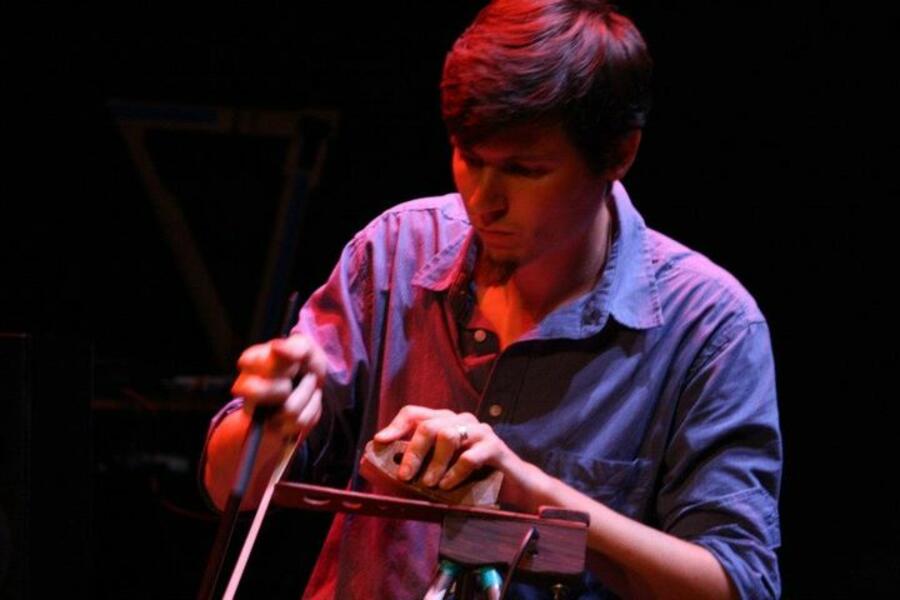 burtplayingdaxophone.jpg
burtplayingdaxophone.jpg -
Burt-HumbabasTrod.mp3Humbaba's Trod is a work composed of daxophone recordings. The daxophone is a bowed wood instrument which is symbolic in relation to Humbaba. Humbaba guarded the cedar forest where the gods lived until Gilgamesh came and fought Humbaba and then cut the trees down to build the gate of a city. The daxophone provides a wide range of sounds (both in pitch and color). It was perfect for generating a rain forest type of environment where each "creature" inhabits a particular range. This work was performed first at Goucher College during the computer music concert.
Music for Piano and Electronics
Samuel Burt learned much from his many pianist friends. Over the past two decades, he's written a significant amount of music for piano, most recently Mixed Signals and Node Ode.
Lisa Weiss and Burt have begun a project to introduce new works for piano and live electronics. Weiss performed Mixed Signals at Goucher College in 2017. Mixed Signals is a work for computer or cell phone that listens to the notes the pianist plays and generates an echoing harmonic cloud, reordering the notes and stretching them out. This work will also be used to christen the new piano at the Immaculate Heart of Mary in March.
The aim of this project is to allow the performer to plug a cell phone into an audio cable and set the phone on the piano and begin performing these new works with minimal effort. Electronic music is often inaccessible to performers with limited computer music background, often requiring that someone else's presence to work through the technology. With modern developments and if programed with great consideration, the composers can reduce the technical requirements.
Lisa Weiss and Burt have begun a project to introduce new works for piano and live electronics. Weiss performed Mixed Signals at Goucher College in 2017. Mixed Signals is a work for computer or cell phone that listens to the notes the pianist plays and generates an echoing harmonic cloud, reordering the notes and stretching them out. This work will also be used to christen the new piano at the Immaculate Heart of Mary in March.
The aim of this project is to allow the performer to plug a cell phone into an audio cable and set the phone on the piano and begin performing these new works with minimal effort. Electronic music is often inaccessible to performers with limited computer music background, often requiring that someone else's presence to work through the technology. With modern developments and if programed with great consideration, the composers can reduce the technical requirements.
-
Mixed SignalsMixed Signals was written for Lisa Weiss. It involves a computer (or phone) tracking piano notes and responding. The pianist plays a solo part written in a flowing, yet rigorously composed style, while the computer answers with randomly reordered notes creating a harmonic cloud. This is the first of a series of works for piano and electronics to be composed in 2018.
-
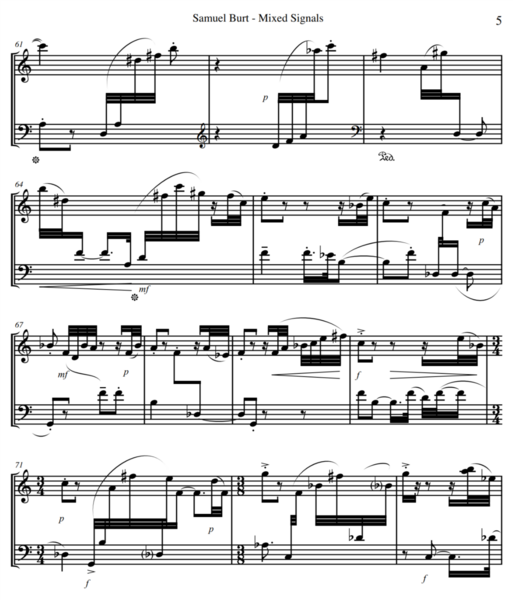 mixed_signals.pngPage 5 of Mixed Signals, a work for piano and cell phone.
mixed_signals.pngPage 5 of Mixed Signals, a work for piano and cell phone. -
Burt-RainMakingConstruct-LeeHancock.mp3Rain Making Construct is a work for solo piano. Burt accomplished his goal to provide intermediate pianists with a piano work that is both simple and complex. The work bridges the gap between Bartok's easy works and Ligeti's most challenging etudes. Like Ligeti, it presents an approach to the piano that is both polyrhythmic and process-oriented where delight and whimsy are both emergent properties. The Billings Music Teachers Association commissioned Rain Making Construct in 2012. Lee Hancock performed and recorded this mp3.
-
 rainmakingconstruct.pngThe first page of Rain Making Construct for solo piano.
rainmakingconstruct.pngThe first page of Rain Making Construct for solo piano. -
Dime NovelAn award winning composition for violin and piano, it breathlessly flies across an abstract landscape and ends in a rhyme. Performed here by Aurelie Baziger and John Chernoff.
-
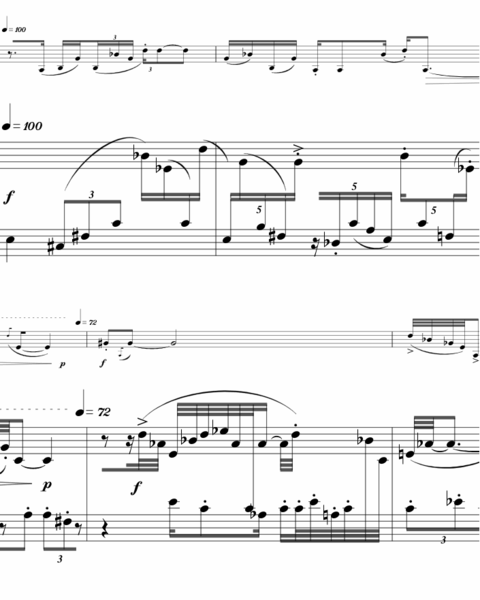 Dime Novel ScorePart of a page from Dime Novel.
Dime Novel ScorePart of a page from Dime Novel. -
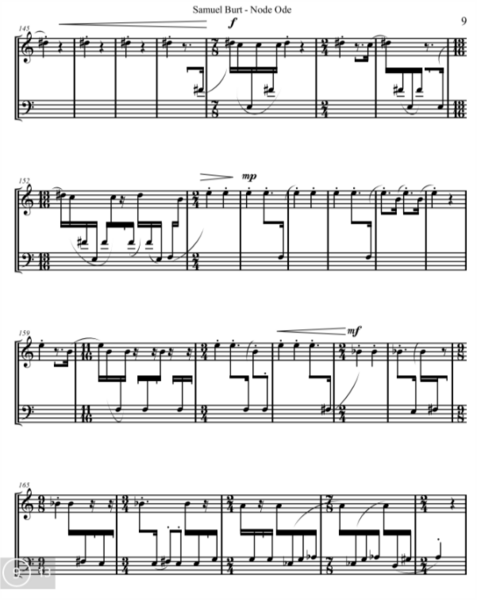 nodeode.pngA page from Node Ode, the newest composition for piano by Samuel Burt. Node Ode explores complexity within the simplicity of repeated notes.
nodeode.pngA page from Node Ode, the newest composition for piano by Samuel Burt. Node Ode explores complexity within the simplicity of repeated notes.







